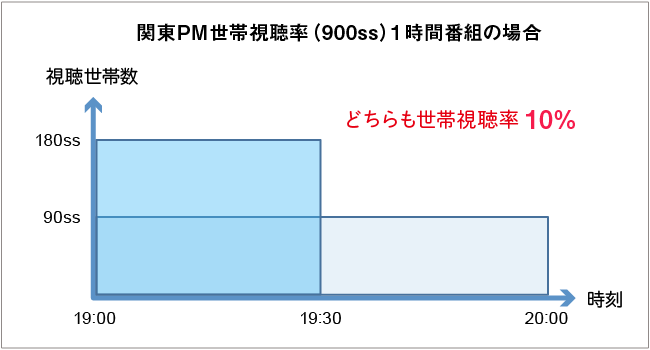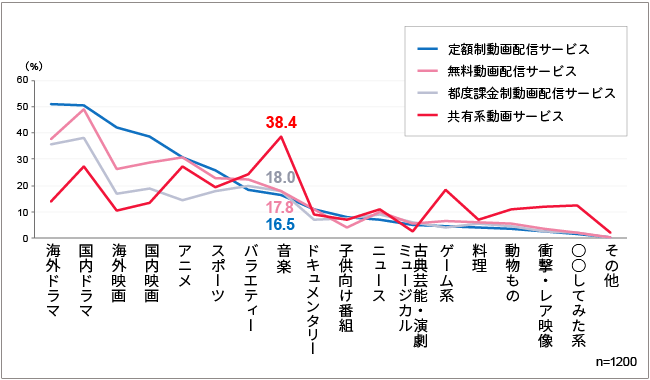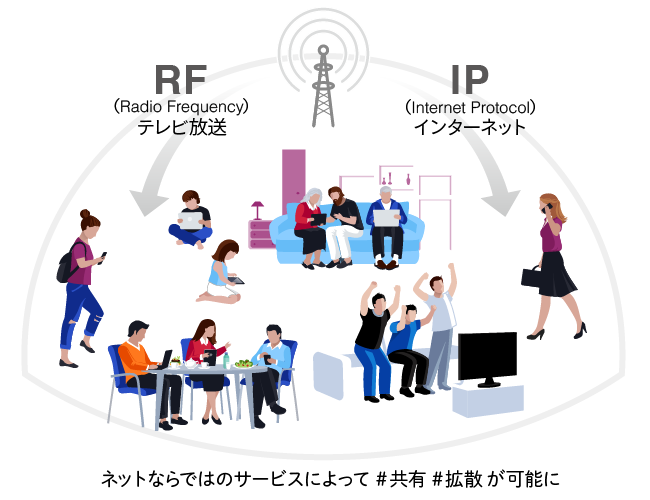This fifth installment marks the finale of our series commemorating the publication of the 'Information Media White Paper 2018'.
As we close out this decade that has featured the potential of smartphones, we believe it is also necessary to recognize the limitations of smartphones (the distinction between what they can and cannot do).
We must maintain a multifaceted perspective on users' information environments, avoiding the trap of "everything on smartphones." From this viewpoint, we explore the potential of "the television system" as a medium, considering its historical and societal value.
Full Circle: Television 2.0
While many video services intensify competition with smartphones as their primary battleground, an increasing number of internet-connected TVs have also led to more people watching videos on the large screens in their living rooms.
In light of these media environment shifts, the opening feature of the 'Information Media White Paper 2017' proposed the perspective of "Back to TV". It suggested that precisely because smartphones and tablets have become widespread, now is the time to circle back and focus on the importance of the TV screen. The 'Information Media White Paper 2018' further contributed "Back to TV 2.0", which takes the user-first perspective even further.
It's common knowledge that "people watch videos on TV too." Yet, the misconception that "videos = something you watch on your smartphone" persists. I feel discussions about "which devices and environments people use to watch videos" are progressing with a disconnect between perception and reality.
Why is the trend of "watching videos on TV" growing stronger? It's simply because smartphones are tools for communication. They aren't used as much for entertainment purposes, and the time spent on them is shorter.
This point is clearly illustrated in the opening feature of the 'Information Media White Paper 2018' and in "App Usage Realities by Gender and Age Group Revealed by Log Data," both based on log data.
While many people watch video services like Hulu, YouTube, AbemaTV, and Netflix on smartphones, the key point is that once they start watching, the longest viewing sessions actually occur on TV.
This stems from the superior viewing environment offered by TV. The tendency to consume entertainment content primarily through television is likely to strengthen further. The TV screen is becoming the main battleground, encompassing not just broadcast TV but also online video and more. As the transformation of the TV business begins, we propose the theory of "back to TV" – partly as a warning.
What "○○ million people watched" on internet TV really means: How view counts differ from ratings
The AbemaTV program "72-Hour Honne TV" (November 2-5, 2017), featuring the three former SMAP members, garnered widespread attention when it announced a "cumulative 74 million views." While this highly impactful figure spread widely, it was also occasionally misunderstood.
For instance, an extreme example was the claim that "74 million divided by 100 million people equals a 74% viewership rating." However, 74 million views is entirely different from 74 million viewers. Dividing by 100 million does not yield a "viewership rating" and has no meaningful significance. Beyond that, I'm concerned about the number of reactions and opinions that clearly didn't properly understand this figure.
Moving forward, we must first correctly understand what viewership ratings mean. While we all encounter news daily like "Drama A recorded a 15% rating" or "Japan's World Cup match exceeded a 30% rating," it feels like this metric isn't always properly understood.
Simply put, television ratings, as shown in Figure 1, represent "area."

Figure 1: Understanding ratings as "area" makes it easier to grasp
For example, in the Kanto region. The number of households with people meters installed is currently 900. If 90 households watched a program all the way through, and the remaining 810 households did not watch it at all, the viewership rating would be 10%.
But what if 180 households watched until the first half of the program, and then everyone stopped watching abruptly during the second half...? This is actually also 10%. Why? Because, as illustrated, the area is the same.
The principle is to average out the times when many people watch and the times when they stop watching, both occurring within a single program's time slot. This is the fundamental principle of television ratings.
On the other hand, the metric used for internet TV is, in most cases, "sessions." Sessions are a score indicating how many times the target program was accessed, making it a different metric from viewership ratings.
As mentioned earlier, since ratings are averaged, longer programs don't necessarily have higher ratings. However, the number of sessions (accesses) increases as the duration lengthens. Viewed this way, it's only natural that a 72-hour program accumulates access continuously throughout its broadcast, resulting in a large number of views (sessions).
The 72-Hour TV program had 74 million sessions, equating to 1.03 million sessions per hour. In contrast, the program "Win Against Koki Kameda and Get 10 Million Yen" broadcast on AbemaTV had 14.2 million sessions over 5 hours, which translates to 2.84 million sessions per hour. When compared on an hourly basis, the Kameda fight was actually "watched" three times more than the 72-Hour TV program.
The point here is not to rank the two programs against each other. Rather, it underscores the importance of thoroughly examining the meaning behind seemingly impactful numbers. A calm analysis allows us to properly reassess what the 72-Hour TV's 74 million viewership figure actually signifies. Moreover, it highlights the sheer nonsense of comparing it to a completely different metric like ratings.
Without considering these circumstances, the argument that "young people are turning away from TV" – claiming they watch internet TV instead – must be seen as unbalanced.
TV's Internet Connectivity Advances

Figure 2: Use of Internet Video Services on Television Sets

Figure 3: Online Video Genres Viewed on Television Sets
Here, let's introduce further data to consider the "full circle back to TV" phenomenon. Figure 2 shows Dentsu Inc.'s survey on the percentage of TV sets connected to the internet, with the latest data indicating this percentage has reached 29%. Of course, it continues to rise steadily.
Among the entire population, including those without a connection, 12.6% watched online video services on a TV set within the past month.
So, what services are they using? Sharing platforms like YouTube are the most common. A key feature is that music videos are frequently watched, as shown in Figure 3. Group interviews revealed that many people compile YouTube music videos into playlists and play them on their TVs as ambient background content.
Why is this? Because many households no longer have stereos or component systems. Often, the main TV speakers offer the best sound quality outside of headphones. The TV has become the highest-quality device in the home for both visual and auditory experiences. This is also an important perspective when considering the modern media environment.
Furthermore, among the 29% who connect their TV to the internet, about half do not watch online videos on that TV. Daily TV usage time is 205 minutes for the "video viewers" and 187 minutes for the "non-video viewers."
Both groups spend nearly the same amount of time watching recorded TV programs. So where is the difference? Among "video viewers," gaming and Blu-ray usage is more active. And they spend less time watching live TV programs. This suggests that connecting the screen to the internet and having various options available may reduce live TV viewing time.
Originally, the television screen was for watching TV programs. That screen is now becoming a platform for various video services. "Is there no place here for broadcasters?"—That is precisely the core of the "Back to TV" theory I've been advocating for the past three years.
The Excellence of "Japanese Television" as a System
Japanese television broadcasting is not only excellent as a service, but also outstanding as a system. Once per season, a different drama airs without fail. Four entirely new dramas are shown annually in the same time slot, all viewable for free, with DVDs released after broadcast ends—this is virtually unheard of in other countries. Typically, window control applies: those who pay get to watch first, while others see it last.
In countries like the United States, subscribing to cable or satellite TV for paid multi-channel services is mainstream. Japan, however, has built approximately 12,000 relay stations nationwide. This infrastructure means anyone with an antenna can watch terrestrial broadcasts for free.
This is why the penetration rate of paid multi-channel broadcasting in Japan is relatively low, around 20%. Japan has a societal structure designed so that television is reliably delivered as terrestrial broadcasts, without needing to depend on the internet or cable.
Under the banner of aiming for 100% reach through the dual system of NHK and commercial broadcasters, this has been in place for over sixty years. Today's terrestrial television broadcasting stands upon the legacy of our predecessors. On the other hand, precisely because this rock-solid system exists, even as other countries begin shifting to online platforms, Japan's progress in this area is arguably slow—for better or worse.
Reach is the very source of media power, and simultaneous broadcasting contributes to its maintenance and expansion.
It's said that about 10% of younger households don't own a TV today. There seems to be a gap in how broadcasters and advertisers perceive this.
Broadcasters operate their business based on viewership ratings, so they may not be accustomed to considering audiences that include people without televisions. Advertisers, on the other hand, are conscious of the problem of how to reach those without TVs. Bridging this gap between the two remains an unfinished challenge.
According to "Japan's Advertising Expenditures," television advertising spending is nearly 2 trillion yen (1.8 trillion yen for terrestrial broadcasts). The foundation of this spending is none other than reach. Maintaining and expanding reach is an urgent priority. Shouldn't simultaneous online streaming be considered as a means to achieve this?
Now is the time to bet on the potential of TV × Share
"Lately, people don't discuss popular TV shows like they used to"—I hear this sentiment more and more. For example, back in the day, there were nationally beloved shows like "8 o'clock! Everyone Gather!" and the next day (or the following week, since it aired on Saturdays), everyone would talk about it at school. Nowadays, TV topics don't seem to come up at school. So, people say TV is no good.
But this is a huge misunderstanding. If you think about it, while people watch TV in their own rooms now, they're actually connected with friends via networks like LINE or Twitter, where they chat about the shows.
In other words, TV topics are shared "in real time" on SNS, creating a situation where there's no need to talk about them the next day. This "people don't talk about TV anymore" argument seems to show how much it views current phenomena through an outdated perspective.
The smartphone era is also the era of sharing. And sharing must be real-time; rapid exchange is essential.
In this regard, one of television's inherent strongest values—its "live nature"—is highly compatible. We should pursue ways to leverage television further, for example, through simultaneous IP (Internet Protocol) streaming services like radiko or AbemaTV.








